Research Methodology for Construction Safety Management Analysis
VerifiedAdded on 2020/05/16
|16
|3584
|166
Report
AI Summary
This report outlines a comprehensive research methodology for investigating safety management in the construction industry. It begins by defining the research aim, rationale, and objectives, emphasizing the importance of safety factors and their impact on project success. The report details a o...
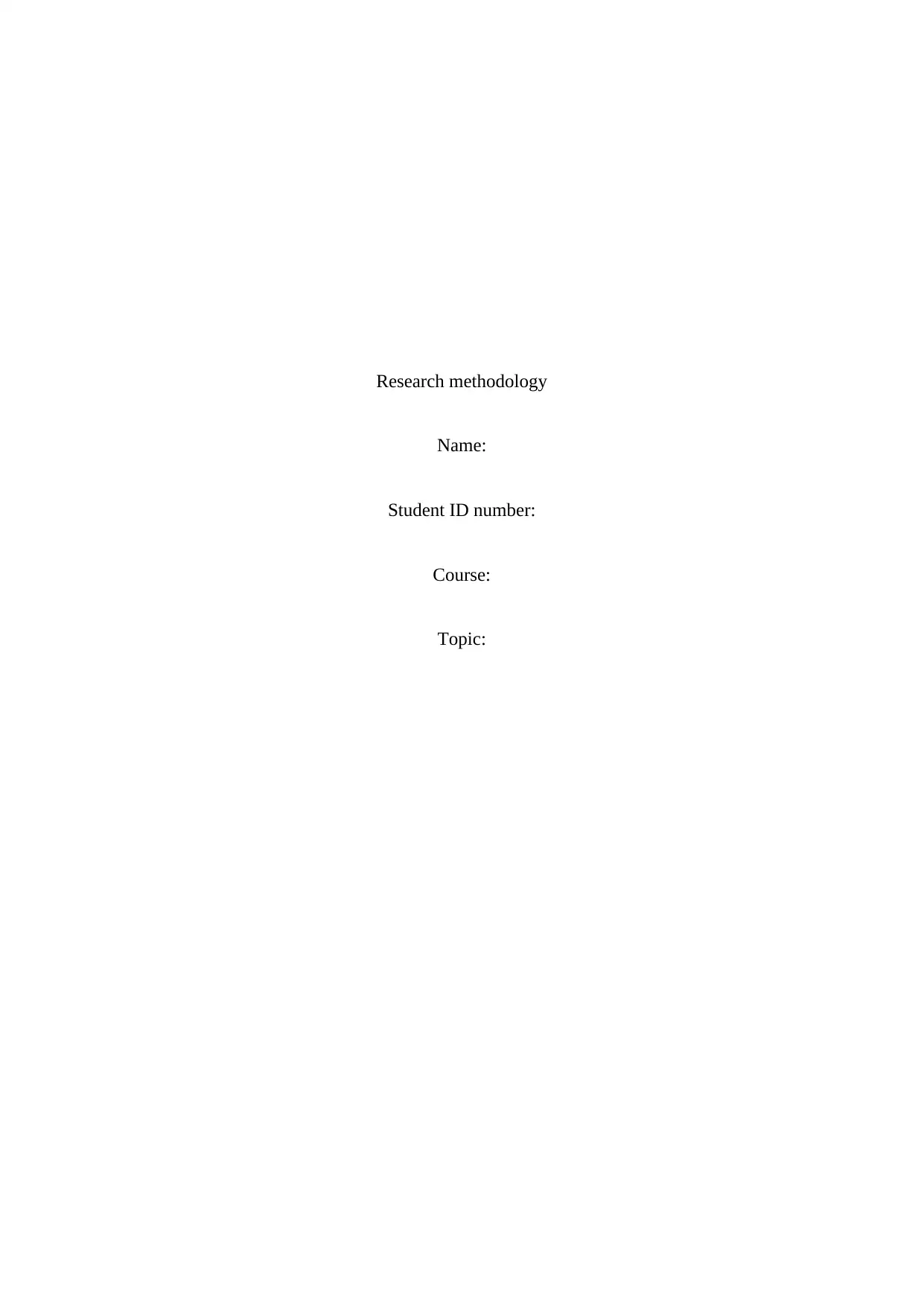
Research methodology
Name:
Student ID number:
Course:
Topic:
Name:
Student ID number:
Course:
Topic:
Paraphrase This Document
Need a fresh take? Get an instant paraphrase of this document with our AI Paraphraser

2
Table of contents
Section 1: Research aim, rationale and objectives…………………………………….3
1.1 The aim of the research........................................................................................3
1.2 The research rationale...........................................................................................3
1.3 The research objectives........................................................................................4
Section 2: Research plan for one year.................................................................................5
2.1 The systems of inquiry.........................................................................................5
2.2 Sequence of methods............................................................................................6
2.3 The selected system of inquiry for the research...................................................7
2.4 Research design....................................................................................................8
2.5 Data analysis techniques.......................................................................................9
Section 3: Research plan for 11 week research project...................................................10
3.1 The detailed description of the quantitative method..........................................10
3.2 Written thesis 11 weeks project............................................................................1
Table of contents
Section 1: Research aim, rationale and objectives…………………………………….3
1.1 The aim of the research........................................................................................3
1.2 The research rationale...........................................................................................3
1.3 The research objectives........................................................................................4
Section 2: Research plan for one year.................................................................................5
2.1 The systems of inquiry.........................................................................................5
2.2 Sequence of methods............................................................................................6
2.3 The selected system of inquiry for the research...................................................7
2.4 Research design....................................................................................................8
2.5 Data analysis techniques.......................................................................................9
Section 3: Research plan for 11 week research project...................................................10
3.1 The detailed description of the quantitative method..........................................10
3.2 Written thesis 11 weeks project............................................................................1
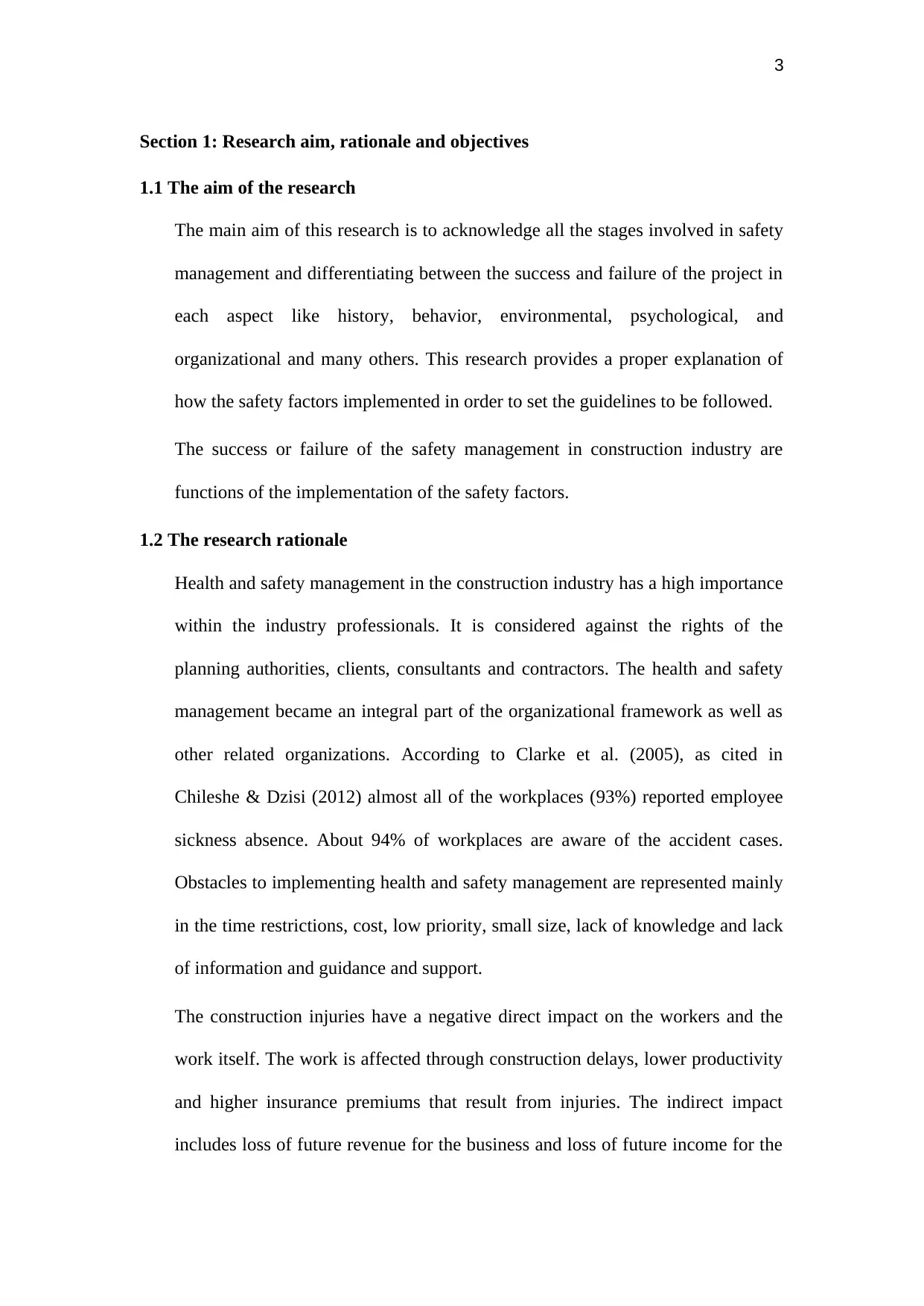
3
Section 1: Research aim, rationale and objectives
1.1 The aim of the research
The main aim of this research is to acknowledge all the stages involved in safety
management and differentiating between the success and failure of the project in
each aspect like history, behavior, environmental, psychological, and
organizational and many others. This research provides a proper explanation of
how the safety factors implemented in order to set the guidelines to be followed.
The success or failure of the safety management in construction industry are
functions of the implementation of the safety factors.
1.2 The research rationale
Health and safety management in the construction industry has a high importance
within the industry professionals. It is considered against the rights of the
planning authorities, clients, consultants and contractors. The health and safety
management became an integral part of the organizational framework as well as
other related organizations. According to Clarke et al. (2005), as cited in
Chileshe & Dzisi (2012) almost all of the workplaces (93%) reported employee
sickness absence. About 94% of workplaces are aware of the accident cases.
Obstacles to implementing health and safety management are represented mainly
in the time restrictions, cost, low priority, small size, lack of knowledge and lack
of information and guidance and support.
The construction injuries have a negative direct impact on the workers and the
work itself. The work is affected through construction delays, lower productivity
and higher insurance premiums that result from injuries. The indirect impact
includes loss of future revenue for the business and loss of future income for the
Section 1: Research aim, rationale and objectives
1.1 The aim of the research
The main aim of this research is to acknowledge all the stages involved in safety
management and differentiating between the success and failure of the project in
each aspect like history, behavior, environmental, psychological, and
organizational and many others. This research provides a proper explanation of
how the safety factors implemented in order to set the guidelines to be followed.
The success or failure of the safety management in construction industry are
functions of the implementation of the safety factors.
1.2 The research rationale
Health and safety management in the construction industry has a high importance
within the industry professionals. It is considered against the rights of the
planning authorities, clients, consultants and contractors. The health and safety
management became an integral part of the organizational framework as well as
other related organizations. According to Clarke et al. (2005), as cited in
Chileshe & Dzisi (2012) almost all of the workplaces (93%) reported employee
sickness absence. About 94% of workplaces are aware of the accident cases.
Obstacles to implementing health and safety management are represented mainly
in the time restrictions, cost, low priority, small size, lack of knowledge and lack
of information and guidance and support.
The construction injuries have a negative direct impact on the workers and the
work itself. The work is affected through construction delays, lower productivity
and higher insurance premiums that result from injuries. The indirect impact
includes loss of future revenue for the business and loss of future income for the
⊘ This is a preview!⊘
Do you want full access?
Subscribe today to unlock all pages.

Trusted by 1+ million students worldwide

4
injured workers. The most common causes of injuries are falls, being caught in or
between objects, electric choke, affection by toxic gases, fire and many other
reasons (Chileshe & Dzisi 2012).
Most of the subcontractors can predict the risks, as the construction of a building
is much more than the skillful performance of the subcontractor. The health and
safety management requires the all trades to work cooperatively during the
project lifetime. Also, legislations have to consider the rights of workers for
having health and safety standards (Wadick 2010).
Risk is considered a probability of a favorable outcome that arises from a
decision. In the construction management, risk is an exposure of economic loss
arising from the involvement in a construction project. Many professionals in the
construction sector do not realize the potential impact on other associated risks
that may impact the business operations. The holistic risk management approach
enables the organization to manage all sources of business risks. It will enhance
the risk mitigation and ensure safety management at workplace (Sharma & Swain
2011).
There is a large amount of literature on health and safety on-site, but there is a
lack of research on the confined construction sites and the increasing level of
risks that workers face in the workplace. According to while Illingworth (2000)
and Cooke and Williams (2004), as cited in Spillane et al., (2012), it is
recommended that an organization make effective design site layout to maximize
space on-site which results in lower risk.
1.3 The research objectives
Assuring proper implementation of safety factors helps in identifying the risks in
construction projects.
injured workers. The most common causes of injuries are falls, being caught in or
between objects, electric choke, affection by toxic gases, fire and many other
reasons (Chileshe & Dzisi 2012).
Most of the subcontractors can predict the risks, as the construction of a building
is much more than the skillful performance of the subcontractor. The health and
safety management requires the all trades to work cooperatively during the
project lifetime. Also, legislations have to consider the rights of workers for
having health and safety standards (Wadick 2010).
Risk is considered a probability of a favorable outcome that arises from a
decision. In the construction management, risk is an exposure of economic loss
arising from the involvement in a construction project. Many professionals in the
construction sector do not realize the potential impact on other associated risks
that may impact the business operations. The holistic risk management approach
enables the organization to manage all sources of business risks. It will enhance
the risk mitigation and ensure safety management at workplace (Sharma & Swain
2011).
There is a large amount of literature on health and safety on-site, but there is a
lack of research on the confined construction sites and the increasing level of
risks that workers face in the workplace. According to while Illingworth (2000)
and Cooke and Williams (2004), as cited in Spillane et al., (2012), it is
recommended that an organization make effective design site layout to maximize
space on-site which results in lower risk.
1.3 The research objectives
Assuring proper implementation of safety factors helps in identifying the risks in
construction projects.
Paraphrase This Document
Need a fresh take? Get an instant paraphrase of this document with our AI Paraphraser
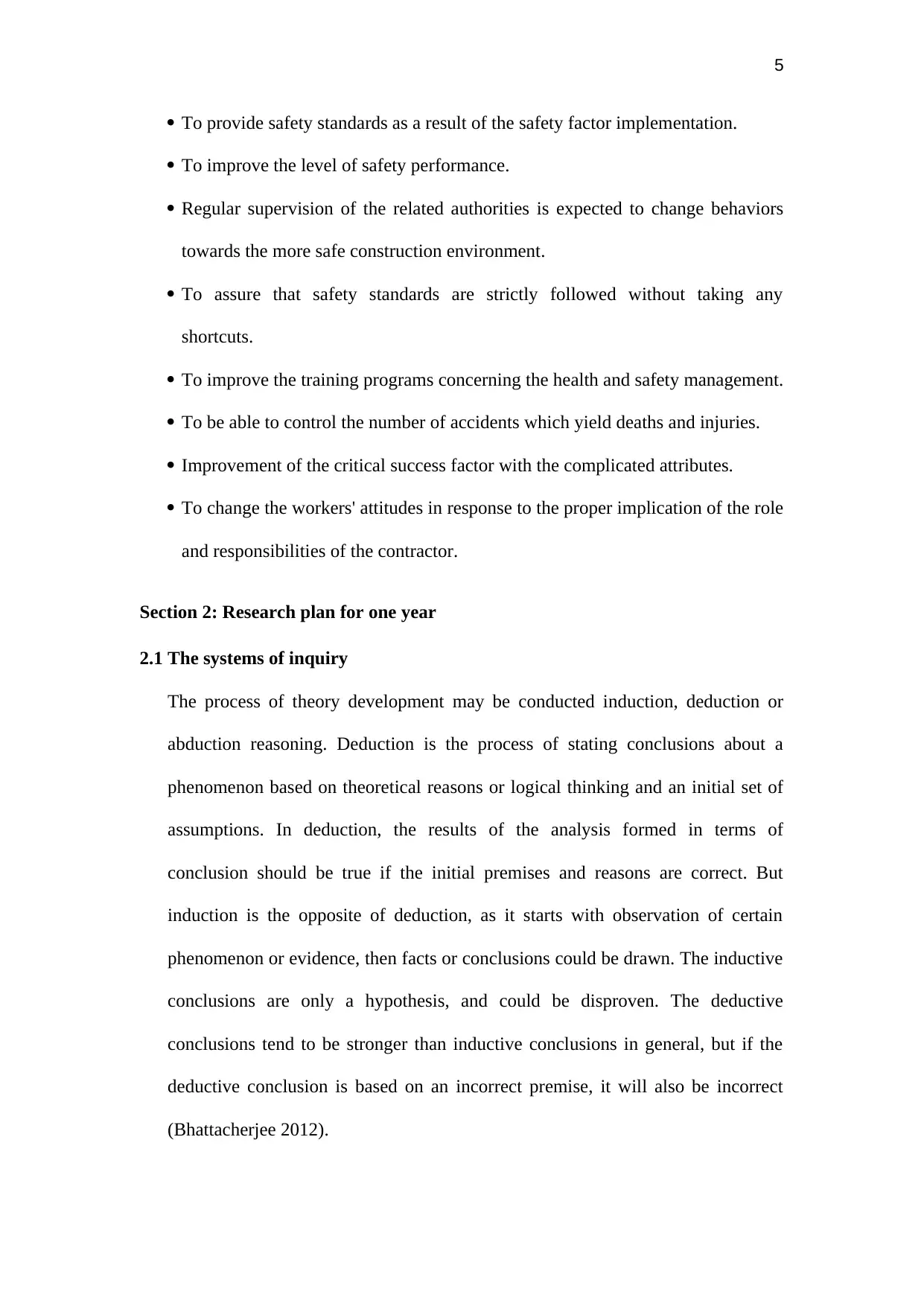
5
To provide safety standards as a result of the safety factor implementation.
To improve the level of safety performance.
Regular supervision of the related authorities is expected to change behaviors
towards the more safe construction environment.
To assure that safety standards are strictly followed without taking any
shortcuts.
To improve the training programs concerning the health and safety management.
To be able to control the number of accidents which yield deaths and injuries.
Improvement of the critical success factor with the complicated attributes.
To change the workers' attitudes in response to the proper implication of the role
and responsibilities of the contractor.
Section 2: Research plan for one year
2.1 The systems of inquiry
The process of theory development may be conducted induction, deduction or
abduction reasoning. Deduction is the process of stating conclusions about a
phenomenon based on theoretical reasons or logical thinking and an initial set of
assumptions. In deduction, the results of the analysis formed in terms of
conclusion should be true if the initial premises and reasons are correct. But
induction is the opposite of deduction, as it starts with observation of certain
phenomenon or evidence, then facts or conclusions could be drawn. The inductive
conclusions are only a hypothesis, and could be disproven. The deductive
conclusions tend to be stronger than inductive conclusions in general, but if the
deductive conclusion is based on an incorrect premise, it will also be incorrect
(Bhattacherjee 2012).
To provide safety standards as a result of the safety factor implementation.
To improve the level of safety performance.
Regular supervision of the related authorities is expected to change behaviors
towards the more safe construction environment.
To assure that safety standards are strictly followed without taking any
shortcuts.
To improve the training programs concerning the health and safety management.
To be able to control the number of accidents which yield deaths and injuries.
Improvement of the critical success factor with the complicated attributes.
To change the workers' attitudes in response to the proper implication of the role
and responsibilities of the contractor.
Section 2: Research plan for one year
2.1 The systems of inquiry
The process of theory development may be conducted induction, deduction or
abduction reasoning. Deduction is the process of stating conclusions about a
phenomenon based on theoretical reasons or logical thinking and an initial set of
assumptions. In deduction, the results of the analysis formed in terms of
conclusion should be true if the initial premises and reasons are correct. But
induction is the opposite of deduction, as it starts with observation of certain
phenomenon or evidence, then facts or conclusions could be drawn. The inductive
conclusions are only a hypothesis, and could be disproven. The deductive
conclusions tend to be stronger than inductive conclusions in general, but if the
deductive conclusion is based on an incorrect premise, it will also be incorrect
(Bhattacherjee 2012).
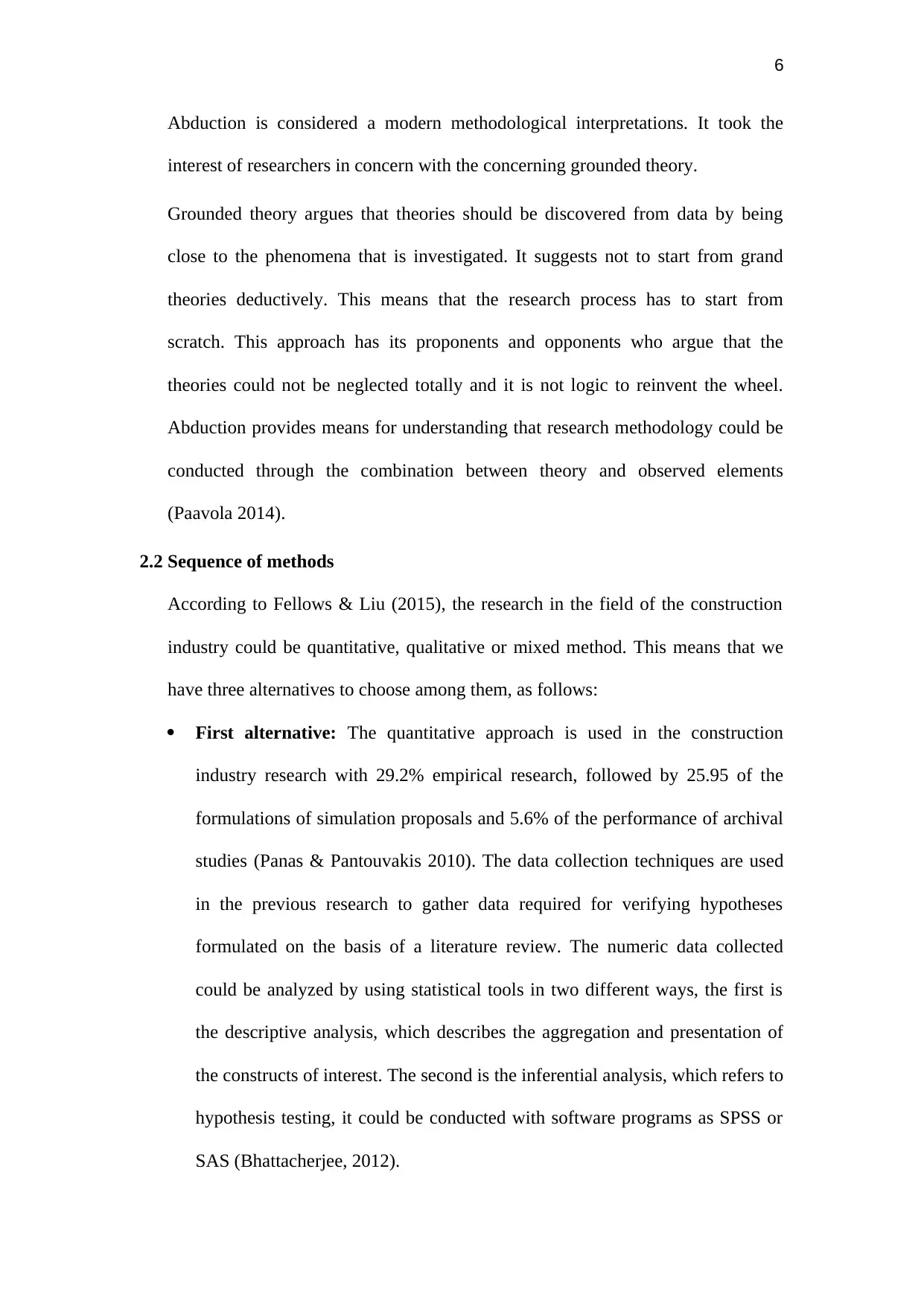
6
Abduction is considered a modern methodological interpretations. It took the
interest of researchers in concern with the concerning grounded theory.
Grounded theory argues that theories should be discovered from data by being
close to the phenomena that is investigated. It suggests not to start from grand
theories deductively. This means that the research process has to start from
scratch. This approach has its proponents and opponents who argue that the
theories could not be neglected totally and it is not logic to reinvent the wheel.
Abduction provides means for understanding that research methodology could be
conducted through the combination between theory and observed elements
(Paavola 2014).
2.2 Sequence of methods
According to Fellows & Liu (2015), the research in the field of the construction
industry could be quantitative, qualitative or mixed method. This means that we
have three alternatives to choose among them, as follows:
First alternative: The quantitative approach is used in the construction
industry research with 29.2% empirical research, followed by 25.95 of the
formulations of simulation proposals and 5.6% of the performance of archival
studies (Panas & Pantouvakis 2010). The data collection techniques are used
in the previous research to gather data required for verifying hypotheses
formulated on the basis of a literature review. The numeric data collected
could be analyzed by using statistical tools in two different ways, the first is
the descriptive analysis, which describes the aggregation and presentation of
the constructs of interest. The second is the inferential analysis, which refers to
hypothesis testing, it could be conducted with software programs as SPSS or
SAS (Bhattacherjee, 2012).
Abduction is considered a modern methodological interpretations. It took the
interest of researchers in concern with the concerning grounded theory.
Grounded theory argues that theories should be discovered from data by being
close to the phenomena that is investigated. It suggests not to start from grand
theories deductively. This means that the research process has to start from
scratch. This approach has its proponents and opponents who argue that the
theories could not be neglected totally and it is not logic to reinvent the wheel.
Abduction provides means for understanding that research methodology could be
conducted through the combination between theory and observed elements
(Paavola 2014).
2.2 Sequence of methods
According to Fellows & Liu (2015), the research in the field of the construction
industry could be quantitative, qualitative or mixed method. This means that we
have three alternatives to choose among them, as follows:
First alternative: The quantitative approach is used in the construction
industry research with 29.2% empirical research, followed by 25.95 of the
formulations of simulation proposals and 5.6% of the performance of archival
studies (Panas & Pantouvakis 2010). The data collection techniques are used
in the previous research to gather data required for verifying hypotheses
formulated on the basis of a literature review. The numeric data collected
could be analyzed by using statistical tools in two different ways, the first is
the descriptive analysis, which describes the aggregation and presentation of
the constructs of interest. The second is the inferential analysis, which refers to
hypothesis testing, it could be conducted with software programs as SPSS or
SAS (Bhattacherjee, 2012).
⊘ This is a preview!⊘
Do you want full access?
Subscribe today to unlock all pages.

Trusted by 1+ million students worldwide
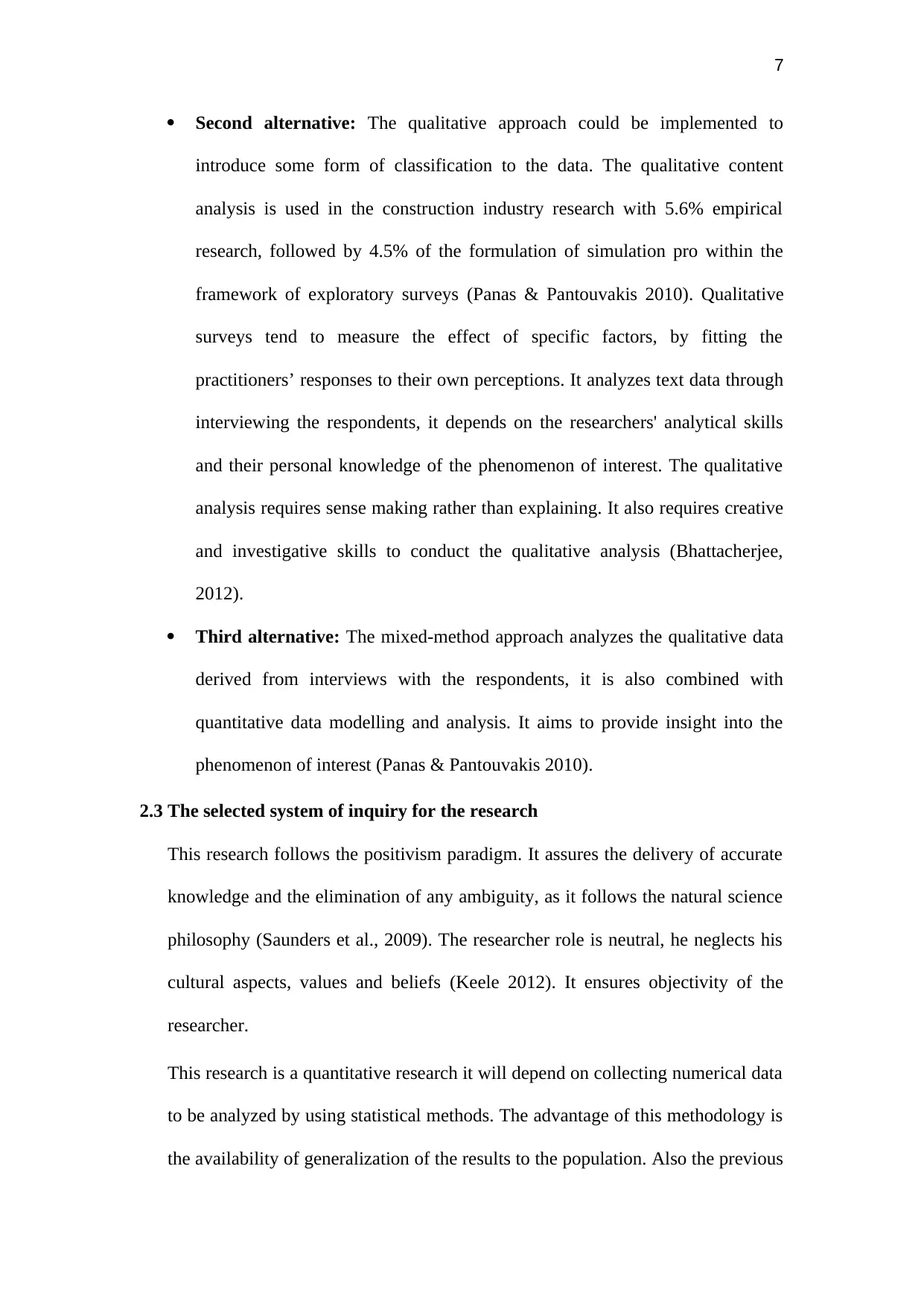
7
Second alternative: The qualitative approach could be implemented to
introduce some form of classification to the data. The qualitative content
analysis is used in the construction industry research with 5.6% empirical
research, followed by 4.5% of the formulation of simulation pro within the
framework of exploratory surveys (Panas & Pantouvakis 2010). Qualitative
surveys tend to measure the effect of specific factors, by fitting the
practitioners’ responses to their own perceptions. It analyzes text data through
interviewing the respondents, it depends on the researchers' analytical skills
and their personal knowledge of the phenomenon of interest. The qualitative
analysis requires sense making rather than explaining. It also requires creative
and investigative skills to conduct the qualitative analysis (Bhattacherjee,
2012).
Third alternative: The mixed-method approach analyzes the qualitative data
derived from interviews with the respondents, it is also combined with
quantitative data modelling and analysis. It aims to provide insight into the
phenomenon of interest (Panas & Pantouvakis 2010).
2.3 The selected system of inquiry for the research
This research follows the positivism paradigm. It assures the delivery of accurate
knowledge and the elimination of any ambiguity, as it follows the natural science
philosophy (Saunders et al., 2009). The researcher role is neutral, he neglects his
cultural aspects, values and beliefs (Keele 2012). It ensures objectivity of the
researcher.
This research is a quantitative research it will depend on collecting numerical data
to be analyzed by using statistical methods. The advantage of this methodology is
the availability of generalization of the results to the population. Also the previous
Second alternative: The qualitative approach could be implemented to
introduce some form of classification to the data. The qualitative content
analysis is used in the construction industry research with 5.6% empirical
research, followed by 4.5% of the formulation of simulation pro within the
framework of exploratory surveys (Panas & Pantouvakis 2010). Qualitative
surveys tend to measure the effect of specific factors, by fitting the
practitioners’ responses to their own perceptions. It analyzes text data through
interviewing the respondents, it depends on the researchers' analytical skills
and their personal knowledge of the phenomenon of interest. The qualitative
analysis requires sense making rather than explaining. It also requires creative
and investigative skills to conduct the qualitative analysis (Bhattacherjee,
2012).
Third alternative: The mixed-method approach analyzes the qualitative data
derived from interviews with the respondents, it is also combined with
quantitative data modelling and analysis. It aims to provide insight into the
phenomenon of interest (Panas & Pantouvakis 2010).
2.3 The selected system of inquiry for the research
This research follows the positivism paradigm. It assures the delivery of accurate
knowledge and the elimination of any ambiguity, as it follows the natural science
philosophy (Saunders et al., 2009). The researcher role is neutral, he neglects his
cultural aspects, values and beliefs (Keele 2012). It ensures objectivity of the
researcher.
This research is a quantitative research it will depend on collecting numerical data
to be analyzed by using statistical methods. The advantage of this methodology is
the availability of generalization of the results to the population. Also the previous
Paraphrase This Document
Need a fresh take? Get an instant paraphrase of this document with our AI Paraphraser
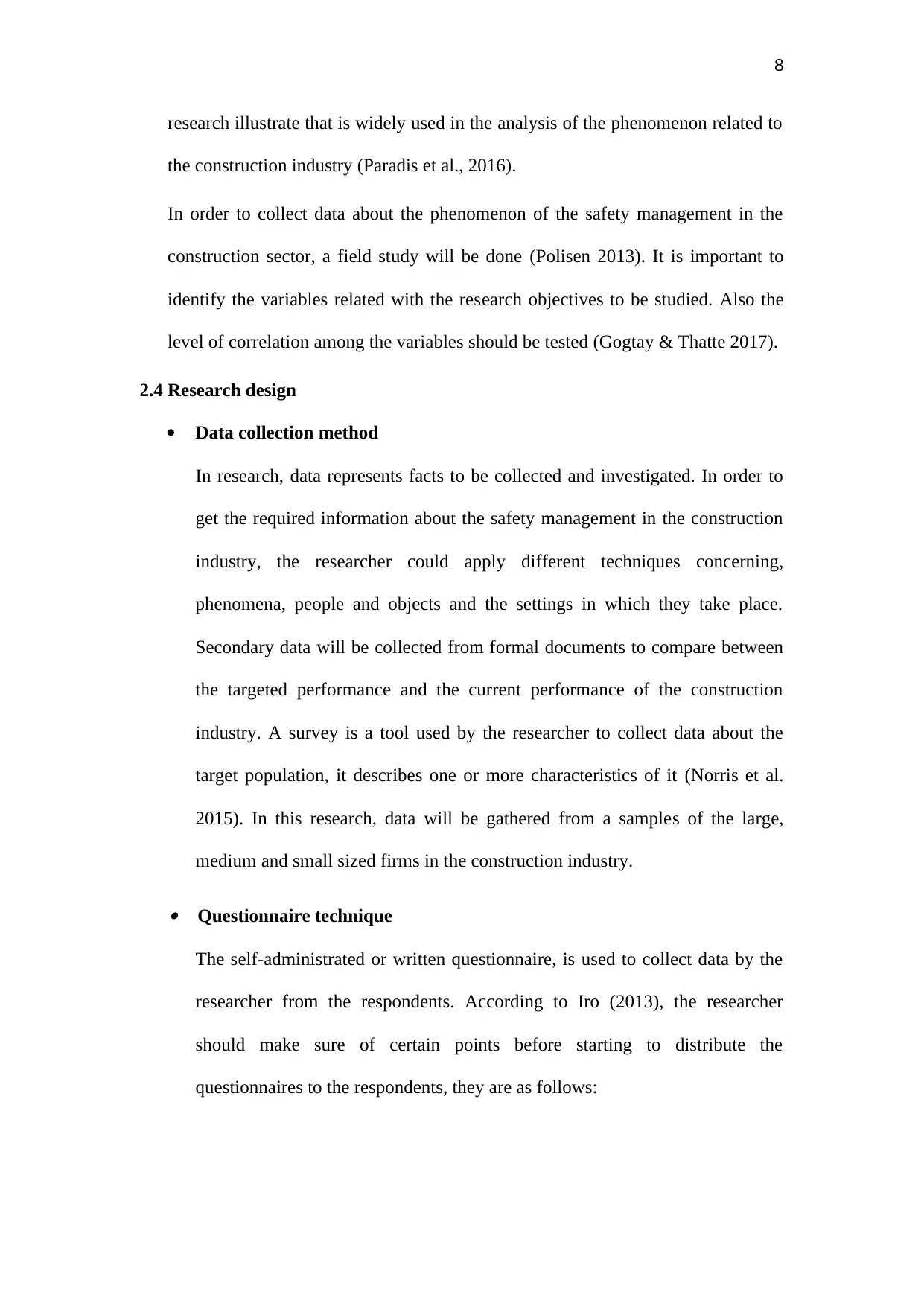
8
research illustrate that is widely used in the analysis of the phenomenon related to
the construction industry (Paradis et al., 2016).
In order to collect data about the phenomenon of the safety management in the
construction sector, a field study will be done (Polisen 2013). It is important to
identify the variables related with the research objectives to be studied. Also the
level of correlation among the variables should be tested (Gogtay & Thatte 2017).
2.4 Research design
Data collection method
In research, data represents facts to be collected and investigated. In order to
get the required information about the safety management in the construction
industry, the researcher could apply different techniques concerning,
phenomena, people and objects and the settings in which they take place.
Secondary data will be collected from formal documents to compare between
the targeted performance and the current performance of the construction
industry. A survey is a tool used by the researcher to collect data about the
target population, it describes one or more characteristics of it (Norris et al.
2015). In this research, data will be gathered from a samples of the large,
medium and small sized firms in the construction industry.
Questionnaire technique
The self-administrated or written questionnaire, is used to collect data by the
researcher from the respondents. According to Iro (2013), the researcher
should make sure of certain points before starting to distribute the
questionnaires to the respondents, they are as follows:
research illustrate that is widely used in the analysis of the phenomenon related to
the construction industry (Paradis et al., 2016).
In order to collect data about the phenomenon of the safety management in the
construction sector, a field study will be done (Polisen 2013). It is important to
identify the variables related with the research objectives to be studied. Also the
level of correlation among the variables should be tested (Gogtay & Thatte 2017).
2.4 Research design
Data collection method
In research, data represents facts to be collected and investigated. In order to
get the required information about the safety management in the construction
industry, the researcher could apply different techniques concerning,
phenomena, people and objects and the settings in which they take place.
Secondary data will be collected from formal documents to compare between
the targeted performance and the current performance of the construction
industry. A survey is a tool used by the researcher to collect data about the
target population, it describes one or more characteristics of it (Norris et al.
2015). In this research, data will be gathered from a samples of the large,
medium and small sized firms in the construction industry.
Questionnaire technique
The self-administrated or written questionnaire, is used to collect data by the
researcher from the respondents. According to Iro (2013), the researcher
should make sure of certain points before starting to distribute the
questionnaires to the respondents, they are as follows:

9
The relevance of the questions to the problem to gather the necessary
data in relation to the phenomenon of interest.
Precision in listing the information sources in order to achieve the
desired objectives.
Assuring that the respondents could easily answer the questions by
making sure of unambiguity of the questions.
Providing enough spaces so that the respondents can answer properly
and express the situations he faces.
Assuring that each question is associated with one element and no
biasness takes place. This requires no duplication in the questions.
To use a structured questionnaire to investigate the variables associated
with the phenomenon.
There are two main types of questionnaires that could be used in data
collection. The first type is the close ended questionnaire, it allows the
respondents to choose among 5 alternatives on the Likert scale ranging
between (strongly agree- agree- neither agree nor disagree- disagree – strongly
disagree) (Zohrabi 2013). The questionnaire should be designed by a
professional of the field of the study. Also, it has to be analyzed with the
appropriate techniques. The method of analysis should be determined a prior,
as it should emerge from the exact setting of investigation. The second type is
the open-ended questionnaire which allows the respondents to express their
opinions towards the phenomenon of research (Bhattacherjee, 2012).
The researcher will use the close-ended questionnaire to allow the respondents
to express and clarify different issues related to the safety at their workplace
(Office of planning, assessment, research, and quality 2015).
The relevance of the questions to the problem to gather the necessary
data in relation to the phenomenon of interest.
Precision in listing the information sources in order to achieve the
desired objectives.
Assuring that the respondents could easily answer the questions by
making sure of unambiguity of the questions.
Providing enough spaces so that the respondents can answer properly
and express the situations he faces.
Assuring that each question is associated with one element and no
biasness takes place. This requires no duplication in the questions.
To use a structured questionnaire to investigate the variables associated
with the phenomenon.
There are two main types of questionnaires that could be used in data
collection. The first type is the close ended questionnaire, it allows the
respondents to choose among 5 alternatives on the Likert scale ranging
between (strongly agree- agree- neither agree nor disagree- disagree – strongly
disagree) (Zohrabi 2013). The questionnaire should be designed by a
professional of the field of the study. Also, it has to be analyzed with the
appropriate techniques. The method of analysis should be determined a prior,
as it should emerge from the exact setting of investigation. The second type is
the open-ended questionnaire which allows the respondents to express their
opinions towards the phenomenon of research (Bhattacherjee, 2012).
The researcher will use the close-ended questionnaire to allow the respondents
to express and clarify different issues related to the safety at their workplace
(Office of planning, assessment, research, and quality 2015).
⊘ This is a preview!⊘
Do you want full access?
Subscribe today to unlock all pages.

Trusted by 1+ million students worldwide
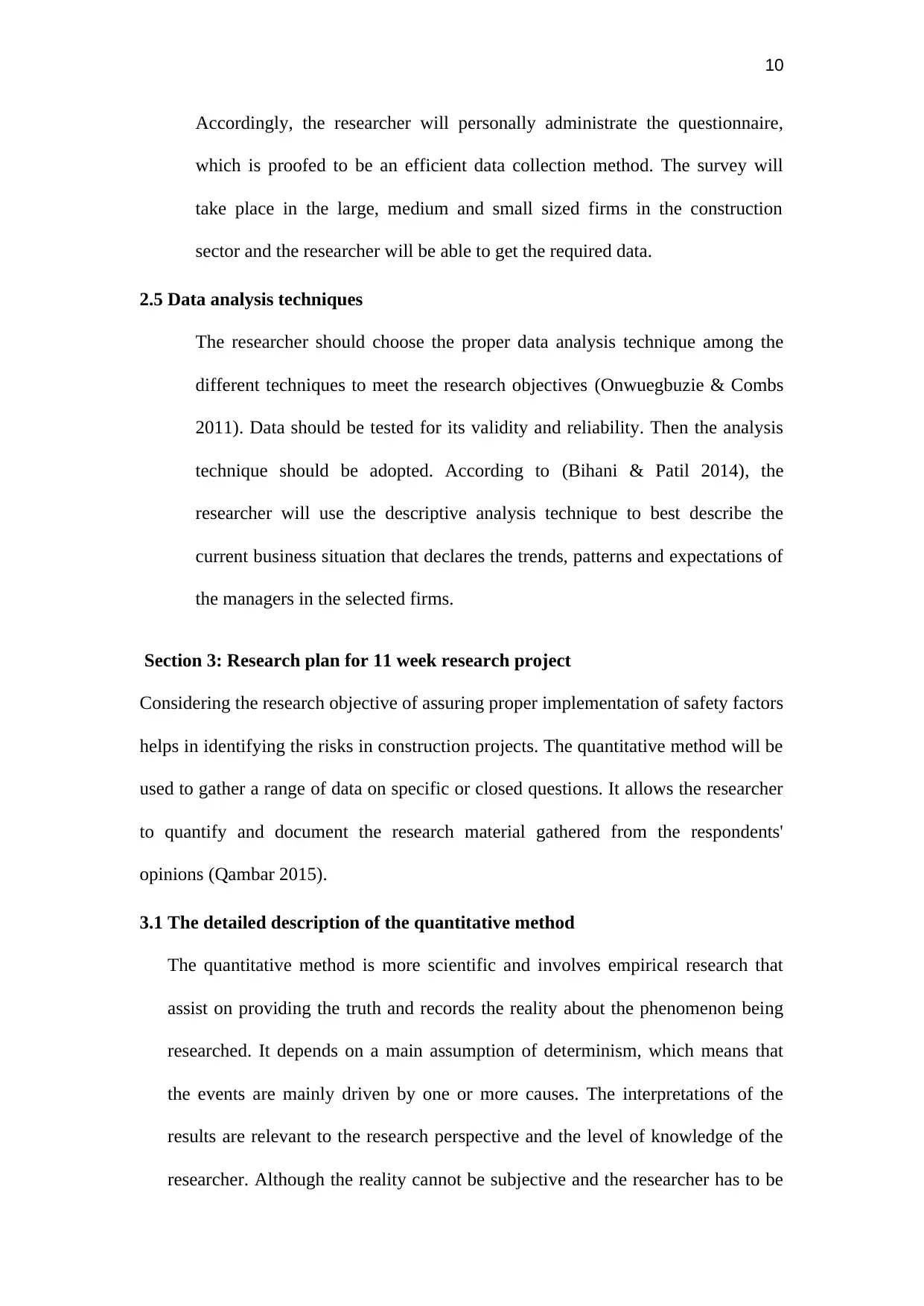
10
Accordingly, the researcher will personally administrate the questionnaire,
which is proofed to be an efficient data collection method. The survey will
take place in the large, medium and small sized firms in the construction
sector and the researcher will be able to get the required data.
2.5 Data analysis techniques
The researcher should choose the proper data analysis technique among the
different techniques to meet the research objectives (Onwuegbuzie & Combs
2011). Data should be tested for its validity and reliability. Then the analysis
technique should be adopted. According to (Bihani & Patil 2014), the
researcher will use the descriptive analysis technique to best describe the
current business situation that declares the trends, patterns and expectations of
the managers in the selected firms.
Section 3: Research plan for 11 week research project
Considering the research objective of assuring proper implementation of safety factors
helps in identifying the risks in construction projects. The quantitative method will be
used to gather a range of data on specific or closed questions. It allows the researcher
to quantify and document the research material gathered from the respondents'
opinions (Qambar 2015).
3.1 The detailed description of the quantitative method
The quantitative method is more scientific and involves empirical research that
assist on providing the truth and records the reality about the phenomenon being
researched. It depends on a main assumption of determinism, which means that
the events are mainly driven by one or more causes. The interpretations of the
results are relevant to the research perspective and the level of knowledge of the
researcher. Although the reality cannot be subjective and the researcher has to be
Accordingly, the researcher will personally administrate the questionnaire,
which is proofed to be an efficient data collection method. The survey will
take place in the large, medium and small sized firms in the construction
sector and the researcher will be able to get the required data.
2.5 Data analysis techniques
The researcher should choose the proper data analysis technique among the
different techniques to meet the research objectives (Onwuegbuzie & Combs
2011). Data should be tested for its validity and reliability. Then the analysis
technique should be adopted. According to (Bihani & Patil 2014), the
researcher will use the descriptive analysis technique to best describe the
current business situation that declares the trends, patterns and expectations of
the managers in the selected firms.
Section 3: Research plan for 11 week research project
Considering the research objective of assuring proper implementation of safety factors
helps in identifying the risks in construction projects. The quantitative method will be
used to gather a range of data on specific or closed questions. It allows the researcher
to quantify and document the research material gathered from the respondents'
opinions (Qambar 2015).
3.1 The detailed description of the quantitative method
The quantitative method is more scientific and involves empirical research that
assist on providing the truth and records the reality about the phenomenon being
researched. It depends on a main assumption of determinism, which means that
the events are mainly driven by one or more causes. The interpretations of the
results are relevant to the research perspective and the level of knowledge of the
researcher. Although the reality cannot be subjective and the researcher has to be
Paraphrase This Document
Need a fresh take? Get an instant paraphrase of this document with our AI Paraphraser
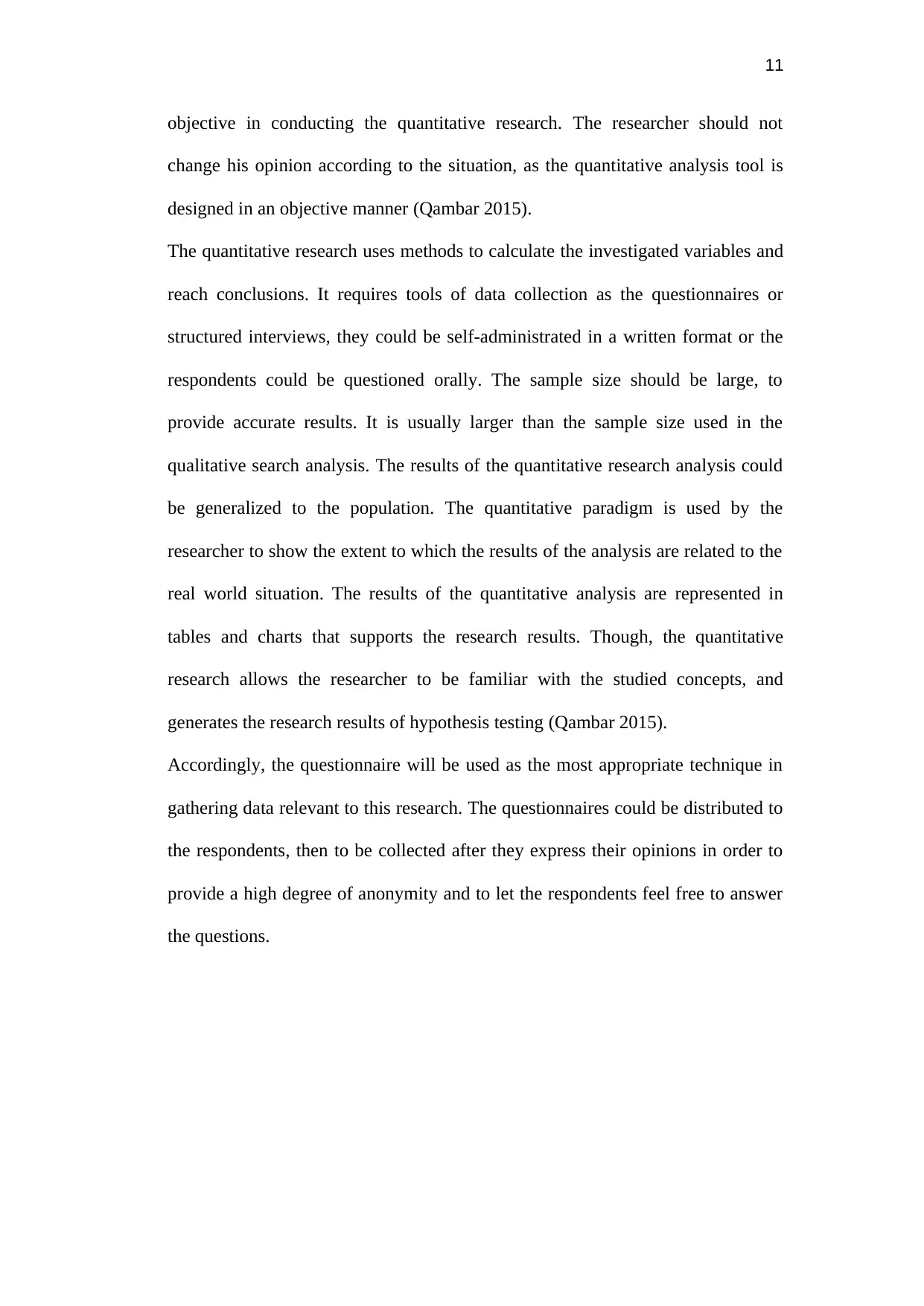
11
objective in conducting the quantitative research. The researcher should not
change his opinion according to the situation, as the quantitative analysis tool is
designed in an objective manner (Qambar 2015).
The quantitative research uses methods to calculate the investigated variables and
reach conclusions. It requires tools of data collection as the questionnaires or
structured interviews, they could be self-administrated in a written format or the
respondents could be questioned orally. The sample size should be large, to
provide accurate results. It is usually larger than the sample size used in the
qualitative search analysis. The results of the quantitative research analysis could
be generalized to the population. The quantitative paradigm is used by the
researcher to show the extent to which the results of the analysis are related to the
real world situation. The results of the quantitative analysis are represented in
tables and charts that supports the research results. Though, the quantitative
research allows the researcher to be familiar with the studied concepts, and
generates the research results of hypothesis testing (Qambar 2015).
Accordingly, the questionnaire will be used as the most appropriate technique in
gathering data relevant to this research. The questionnaires could be distributed to
the respondents, then to be collected after they express their opinions in order to
provide a high degree of anonymity and to let the respondents feel free to answer
the questions.
objective in conducting the quantitative research. The researcher should not
change his opinion according to the situation, as the quantitative analysis tool is
designed in an objective manner (Qambar 2015).
The quantitative research uses methods to calculate the investigated variables and
reach conclusions. It requires tools of data collection as the questionnaires or
structured interviews, they could be self-administrated in a written format or the
respondents could be questioned orally. The sample size should be large, to
provide accurate results. It is usually larger than the sample size used in the
qualitative search analysis. The results of the quantitative research analysis could
be generalized to the population. The quantitative paradigm is used by the
researcher to show the extent to which the results of the analysis are related to the
real world situation. The results of the quantitative analysis are represented in
tables and charts that supports the research results. Though, the quantitative
research allows the researcher to be familiar with the studied concepts, and
generates the research results of hypothesis testing (Qambar 2015).
Accordingly, the questionnaire will be used as the most appropriate technique in
gathering data relevant to this research. The questionnaires could be distributed to
the respondents, then to be collected after they express their opinions in order to
provide a high degree of anonymity and to let the respondents feel free to answer
the questions.
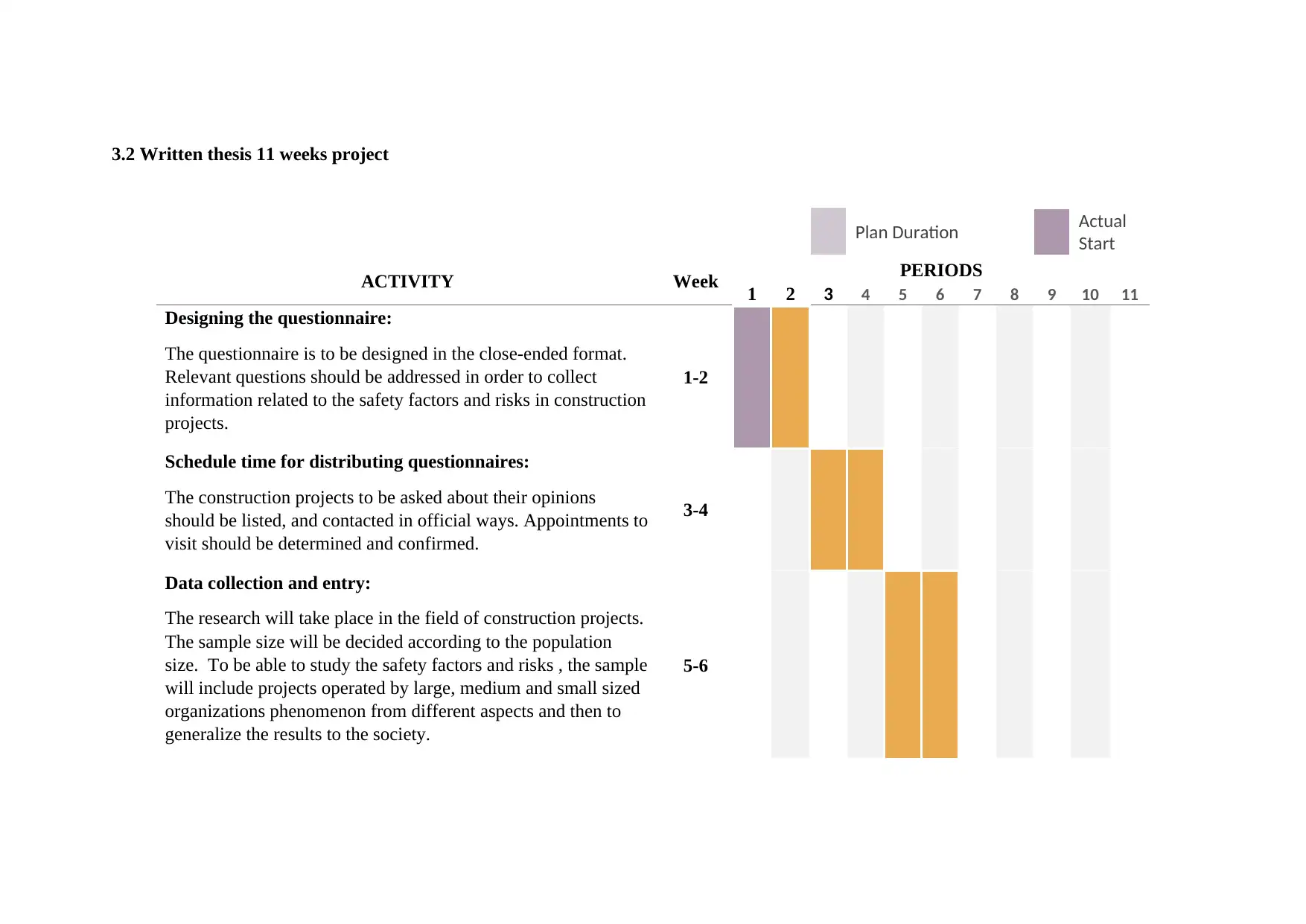
3.2 Written thesis 11 weeks project
Plan Duration Actual
Start
ACTIVITY Week PERIODS
1 2 3 4 5 6 7 8 9 10 11
Designing the questionnaire:
The questionnaire is to be designed in the close-ended format.
Relevant questions should be addressed in order to collect
information related to the safety factors and risks in construction
projects.
1-2
Schedule time for distributing questionnaires:
The construction projects to be asked about their opinions
should be listed, and contacted in official ways. Appointments to
visit should be determined and confirmed.
3-4
Data collection and entry:
The research will take place in the field of construction projects.
The sample size will be decided according to the population
size. To be able to study the safety factors and risks , the sample
will include projects operated by large, medium and small sized
organizations phenomenon from different aspects and then to
generalize the results to the society.
5-6
Plan Duration Actual
Start
ACTIVITY Week PERIODS
1 2 3 4 5 6 7 8 9 10 11
Designing the questionnaire:
The questionnaire is to be designed in the close-ended format.
Relevant questions should be addressed in order to collect
information related to the safety factors and risks in construction
projects.
1-2
Schedule time for distributing questionnaires:
The construction projects to be asked about their opinions
should be listed, and contacted in official ways. Appointments to
visit should be determined and confirmed.
3-4
Data collection and entry:
The research will take place in the field of construction projects.
The sample size will be decided according to the population
size. To be able to study the safety factors and risks , the sample
will include projects operated by large, medium and small sized
organizations phenomenon from different aspects and then to
generalize the results to the society.
5-6
⊘ This is a preview!⊘
Do you want full access?
Subscribe today to unlock all pages.

Trusted by 1+ million students worldwide
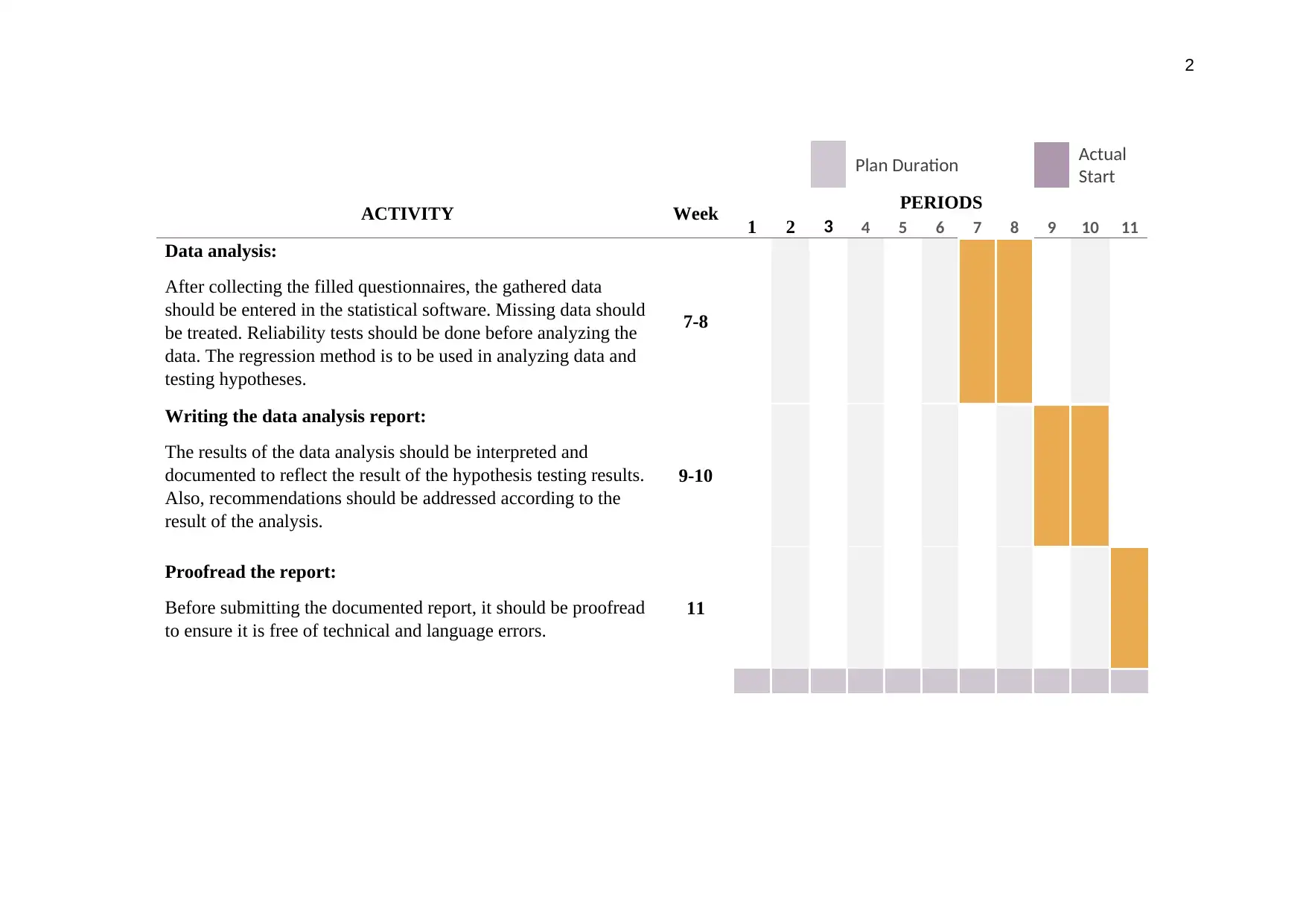
2
Plan Duration Actual
Start
ACTIVITY Week PERIODS
1 2 3 4 5 6 7 8 9 10 11
Data analysis:
After collecting the filled questionnaires, the gathered data
should be entered in the statistical software. Missing data should
be treated. Reliability tests should be done before analyzing the
data. The regression method is to be used in analyzing data and
testing hypotheses.
7-8
Writing the data analysis report:
The results of the data analysis should be interpreted and
documented to reflect the result of the hypothesis testing results.
Also, recommendations should be addressed according to the
result of the analysis.
9-10
Proofread the report:
Before submitting the documented report, it should be proofread
to ensure it is free of technical and language errors.
11
Plan Duration Actual
Start
ACTIVITY Week PERIODS
1 2 3 4 5 6 7 8 9 10 11
Data analysis:
After collecting the filled questionnaires, the gathered data
should be entered in the statistical software. Missing data should
be treated. Reliability tests should be done before analyzing the
data. The regression method is to be used in analyzing data and
testing hypotheses.
7-8
Writing the data analysis report:
The results of the data analysis should be interpreted and
documented to reflect the result of the hypothesis testing results.
Also, recommendations should be addressed according to the
result of the analysis.
9-10
Proofread the report:
Before submitting the documented report, it should be proofread
to ensure it is free of technical and language errors.
11
Paraphrase This Document
Need a fresh take? Get an instant paraphrase of this document with our AI Paraphraser
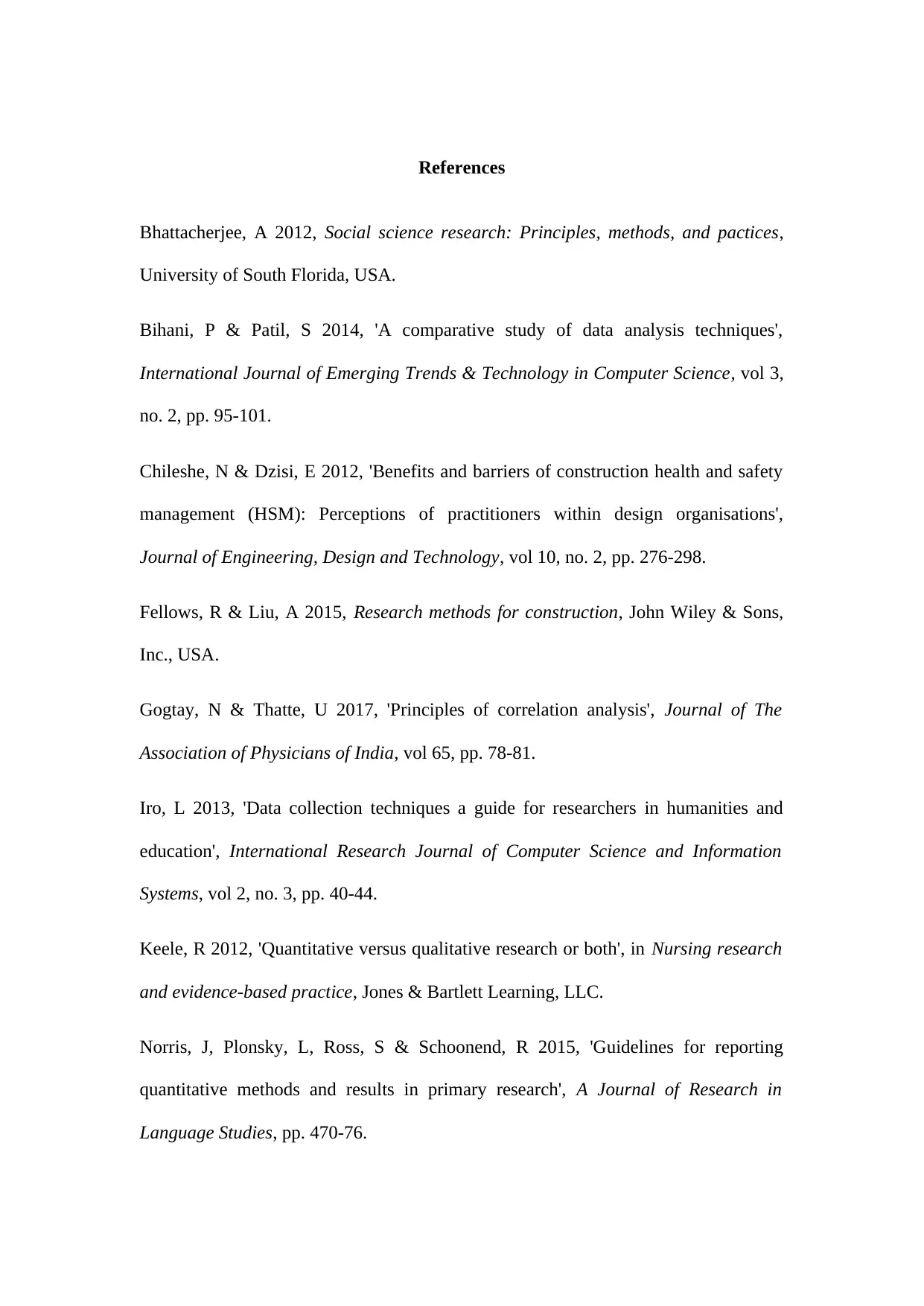
References
Bhattacherjee, A 2012, Social science research: Principles, methods, and pactices,
University of South Florida, USA.
Bihani, P & Patil, S 2014, 'A comparative study of data analysis techniques',
International Journal of Emerging Trends & Technology in Computer Science, vol 3,
no. 2, pp. 95-101.
Chileshe, N & Dzisi, E 2012, 'Benefits and barriers of construction health and safety
management (HSM): Perceptions of practitioners within design organisations',
Journal of Engineering, Design and Technology, vol 10, no. 2, pp. 276-298.
Fellows, R & Liu, A 2015, Research methods for construction, John Wiley & Sons,
Inc., USA.
Gogtay, N & Thatte, U 2017, 'Principles of correlation analysis', Journal of The
Association of Physicians of India, vol 65, pp. 78-81.
Iro, L 2013, 'Data collection techniques a guide for researchers in humanities and
education', International Research Journal of Computer Science and Information
Systems, vol 2, no. 3, pp. 40-44.
Keele, R 2012, 'Quantitative versus qualitative research or both', in Nursing research
and evidence-based practice, Jones & Bartlett Learning, LLC.
Norris, J, Plonsky, L, Ross, S & Schoonend, R 2015, 'Guidelines for reporting
quantitative methods and results in primary research', A Journal of Research in
Language Studies, pp. 470-76.
Bhattacherjee, A 2012, Social science research: Principles, methods, and pactices,
University of South Florida, USA.
Bihani, P & Patil, S 2014, 'A comparative study of data analysis techniques',
International Journal of Emerging Trends & Technology in Computer Science, vol 3,
no. 2, pp. 95-101.
Chileshe, N & Dzisi, E 2012, 'Benefits and barriers of construction health and safety
management (HSM): Perceptions of practitioners within design organisations',
Journal of Engineering, Design and Technology, vol 10, no. 2, pp. 276-298.
Fellows, R & Liu, A 2015, Research methods for construction, John Wiley & Sons,
Inc., USA.
Gogtay, N & Thatte, U 2017, 'Principles of correlation analysis', Journal of The
Association of Physicians of India, vol 65, pp. 78-81.
Iro, L 2013, 'Data collection techniques a guide for researchers in humanities and
education', International Research Journal of Computer Science and Information
Systems, vol 2, no. 3, pp. 40-44.
Keele, R 2012, 'Quantitative versus qualitative research or both', in Nursing research
and evidence-based practice, Jones & Bartlett Learning, LLC.
Norris, J, Plonsky, L, Ross, S & Schoonend, R 2015, 'Guidelines for reporting
quantitative methods and results in primary research', A Journal of Research in
Language Studies, pp. 470-76.
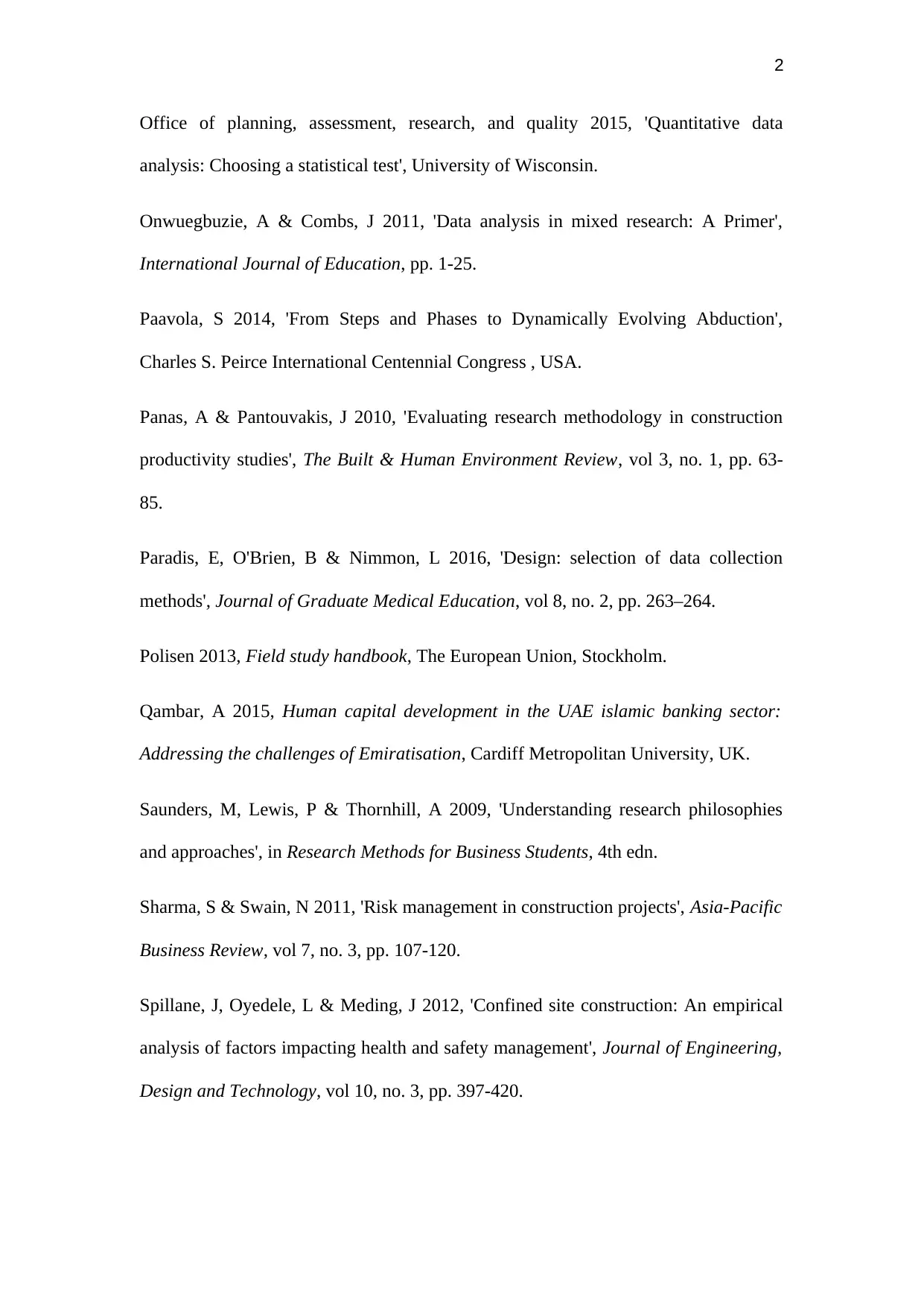
2
Office of planning, assessment, research, and quality 2015, 'Quantitative data
analysis: Choosing a statistical test', University of Wisconsin.
Onwuegbuzie, A & Combs, J 2011, 'Data analysis in mixed research: A Primer',
International Journal of Education, pp. 1-25.
Paavola, S 2014, 'From Steps and Phases to Dynamically Evolving Abduction',
Charles S. Peirce International Centennial Congress , USA.
Panas, A & Pantouvakis, J 2010, 'Evaluating research methodology in construction
productivity studies', The Built & Human Environment Review, vol 3, no. 1, pp. 63-
85.
Paradis, E, O'Brien, B & Nimmon, L 2016, 'Design: selection of data collection
methods', Journal of Graduate Medical Education, vol 8, no. 2, pp. 263–264.
Polisen 2013, Field study handbook, The European Union, Stockholm.
Qambar, A 2015, Human capital development in the UAE islamic banking sector:
Addressing the challenges of Emiratisation, Cardiff Metropolitan University, UK.
Saunders, M, Lewis, P & Thornhill, A 2009, 'Understanding research philosophies
and approaches', in Research Methods for Business Students, 4th edn.
Sharma, S & Swain, N 2011, 'Risk management in construction projects', Asia-Pacific
Business Review, vol 7, no. 3, pp. 107-120.
Spillane, J, Oyedele, L & Meding, J 2012, 'Confined site construction: An empirical
analysis of factors impacting health and safety management', Journal of Engineering,
Design and Technology, vol 10, no. 3, pp. 397-420.
Office of planning, assessment, research, and quality 2015, 'Quantitative data
analysis: Choosing a statistical test', University of Wisconsin.
Onwuegbuzie, A & Combs, J 2011, 'Data analysis in mixed research: A Primer',
International Journal of Education, pp. 1-25.
Paavola, S 2014, 'From Steps and Phases to Dynamically Evolving Abduction',
Charles S. Peirce International Centennial Congress , USA.
Panas, A & Pantouvakis, J 2010, 'Evaluating research methodology in construction
productivity studies', The Built & Human Environment Review, vol 3, no. 1, pp. 63-
85.
Paradis, E, O'Brien, B & Nimmon, L 2016, 'Design: selection of data collection
methods', Journal of Graduate Medical Education, vol 8, no. 2, pp. 263–264.
Polisen 2013, Field study handbook, The European Union, Stockholm.
Qambar, A 2015, Human capital development in the UAE islamic banking sector:
Addressing the challenges of Emiratisation, Cardiff Metropolitan University, UK.
Saunders, M, Lewis, P & Thornhill, A 2009, 'Understanding research philosophies
and approaches', in Research Methods for Business Students, 4th edn.
Sharma, S & Swain, N 2011, 'Risk management in construction projects', Asia-Pacific
Business Review, vol 7, no. 3, pp. 107-120.
Spillane, J, Oyedele, L & Meding, J 2012, 'Confined site construction: An empirical
analysis of factors impacting health and safety management', Journal of Engineering,
Design and Technology, vol 10, no. 3, pp. 397-420.
⊘ This is a preview!⊘
Do you want full access?
Subscribe today to unlock all pages.

Trusted by 1+ million students worldwide
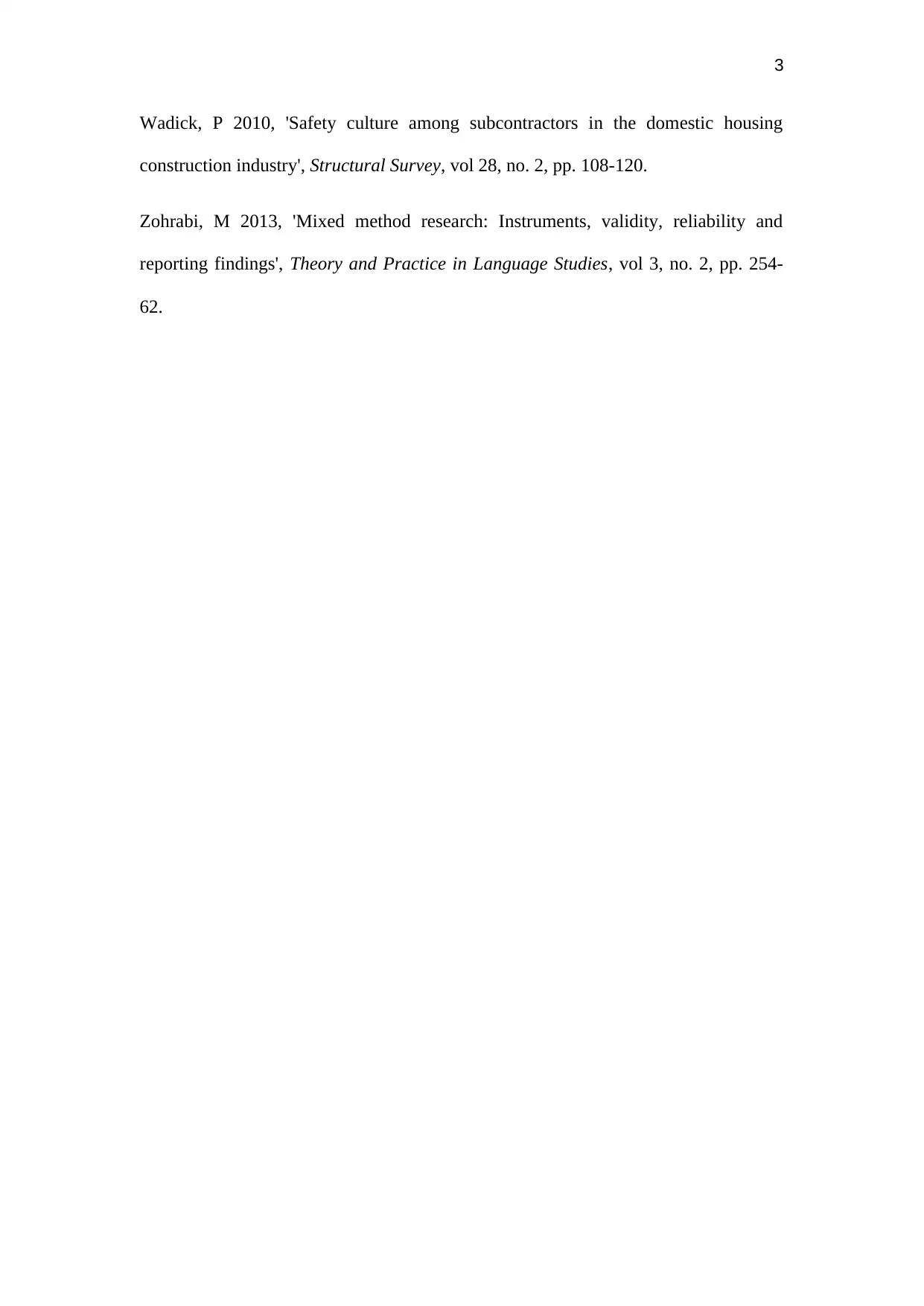
3
Wadick, P 2010, 'Safety culture among subcontractors in the domestic housing
construction industry', Structural Survey, vol 28, no. 2, pp. 108-120.
Zohrabi, M 2013, 'Mixed method research: Instruments, validity, reliability and
reporting findings', Theory and Practice in Language Studies, vol 3, no. 2, pp. 254-
62.
Wadick, P 2010, 'Safety culture among subcontractors in the domestic housing
construction industry', Structural Survey, vol 28, no. 2, pp. 108-120.
Zohrabi, M 2013, 'Mixed method research: Instruments, validity, reliability and
reporting findings', Theory and Practice in Language Studies, vol 3, no. 2, pp. 254-
62.
1 out of 16
Related Documents
Your All-in-One AI-Powered Toolkit for Academic Success.
+13062052269
info@desklib.com
Available 24*7 on WhatsApp / Email
![[object Object]](/_next/static/media/star-bottom.7253800d.svg)
Unlock your academic potential
© 2024 | Zucol Services PVT LTD | All rights reserved.




